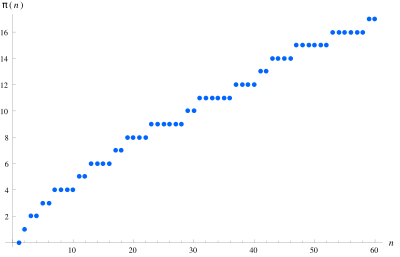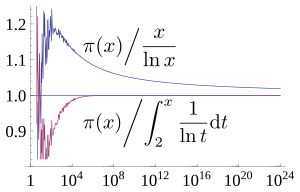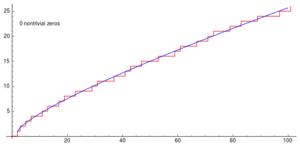Prime-counting function facts for kids
In mathematics, the prime-counting function is the function counting the number of prime numbers less than or equal to some real number x. It is denoted by π(x) (unrelated to the number π).
Contents
Growth rate
Of great interest in number theory is the growth rate of the prime-counting function. It was conjectured in the end of the 18th century by Gauss and by Legendre to be approximately  where log is the natural logarithm, in the sense that
where log is the natural logarithm, in the sense that 
This statement is the prime number theorem. An equivalent statement is

where li is the logarithmic integral function. The prime number theorem was first proved in 1896 by Jacques Hadamard and by Charles de la Vallée Poussin independently, using properties of the Riemann zeta function introduced by Riemann in 1859. Proofs of the prime number theorem not using the zeta function or complex analysis were found around 1948 by Atle Selberg and by Paul Erdős (for the most part independently).
More precise estimates
In 1899, de la Vallée Poussin proved that

for some positive constant a. Here, O(...) is the big O notation.
More precise estimates of  are now known. For example, in 2002, Kevin Ford proved that
are now known. For example, in 2002, Kevin Ford proved that 
Mossinghoff and Trudgian proved an explicit upper bound for the difference between  and
and  :
:  for
for  .
.
For values of  that are not unreasonably large,
that are not unreasonably large,  is greater than
is greater than  . However,
. However,  is known to change sign infinitely many times. For a discussion of this, see Skewes' number.
is known to change sign infinitely many times. For a discussion of this, see Skewes' number.
Exact form
For  let
let  when
when  is a prime number, and
is a prime number, and  otherwise. Bernhard Riemann, in his work On the Number of Primes Less Than a Given Magnitude, proved that
otherwise. Bernhard Riemann, in his work On the Number of Primes Less Than a Given Magnitude, proved that  is equal to
is equal to  where
where  μ(n) is the Möbius function, li(x) is the logarithmic integral function, ρ indexes every zero of the Riemann zeta function, and li(xρ/n) is not evaluated with a branch cut but instead considered as Ei(ρn log x) where Ei(x) is the exponential integral. If the trivial zeros are collected and the sum is taken only over the non-trivial zeros ρ of the Riemann zeta function, then
μ(n) is the Möbius function, li(x) is the logarithmic integral function, ρ indexes every zero of the Riemann zeta function, and li(xρ/n) is not evaluated with a branch cut but instead considered as Ei(ρn log x) where Ei(x) is the exponential integral. If the trivial zeros are collected and the sum is taken only over the non-trivial zeros ρ of the Riemann zeta function, then  may be approximated by
may be approximated by 
The Riemann hypothesis suggests that every such non-trivial zero lies along Re(s) = 12.
Table of π(x), x / log x, and li(x)
The table shows how the three functions π(x), x / log x and li(x) compare at powers of 10. See also, and
-
x π(x) π(x) − x / log x li(x) − π(x) x / π(x) x / log x % Error 10 4 0 2 2.500 -8.57% 102 25 3 5 4.000 13.14% 103 168 23 10 5.952 13.83% 104 1,229 143 17 8.137 11.66% 105 9,592 906 38 10.425 9.45% 106 78,498 6,116 130 12.739 7.79% 107 664,579 44,158 339 15.047 6.64% 108 5,761,455 332,774 754 17.357 5.78% 109 50,847,534 2,592,592 1,701 19.667 5.10% 1010 455,052,511 20,758,029 3,104 21.975 4.56% 1011 4,118,054,813 169,923,159 11,588 24.283 4.13% 1012 37,607,912,018 1,416,705,193 38,263 26.590 3.77% 1013 346,065,536,839 11,992,858,452 108,971 28.896 3.47% 1014 3,204,941,750,802 102,838,308,636 314,890 31.202 3.21% 1015 29,844,570,422,669 891,604,962,452 1,052,619 33.507 2.99% 1016 279,238,341,033,925 7,804,289,844,393 3,214,632 35.812 2.79% 1017 2,623,557,157,654,233 68,883,734,693,928 7,956,589 38.116 2.63% 1018 24,739,954,287,740,860 612,483,070,893,536 21,949,555 40.420 2.48% 1019 234,057,667,276,344,607 5,481,624,169,369,961 99,877,775 42.725 2.34% 1020 2,220,819,602,560,918,840 49,347,193,044,659,702 222,744,644 45.028 2.22% 1021 21,127,269,486,018,731,928 446,579,871,578,168,707 597,394,254 47.332 2.11% 1022 201,467,286,689,315,906,290 4,060,704,006,019,620,994 1,932,355,208 49.636 2.02% 1023 1,925,320,391,606,803,968,923 37,083,513,766,578,631,309 7,250,186,216 51.939 1.93% 1024 18,435,599,767,349,200,867,866 339,996,354,713,708,049,069 17,146,907,278 54.243 1.84% 1025 176,846,309,399,143,769,411,680 3,128,516,637,843,038,351,228 55,160,980,939 56.546 1.77% 1026 1,699,246,750,872,437,141,327,603 28,883,358,936,853,188,823,261 155,891,678,121 58.850 1.70% 1027 16,352,460,426,841,680,446,427,399 267,479,615,610,131,274,163,365 508,666,658,006 61.153 1.64% 1028 157,589,269,275,973,410,412,739,598 2,484,097,167,669,186,251,622,127 1,427,745,660,374 63.456 1.58% 1029 1,520,698,109,714,272,166,094,258,063 23,130,930,737,541,725,917,951,446 4,551,193,622,464 65.759 1.52%
In the On-Line Encyclopedia of Integer Sequences, the π(x) column is sequence OEIS: A006880, π(x) − x/log x is sequence OEIS: A057835, and li(x) − π(x) is sequence OEIS: A057752.
The value for π(1024) was originally computed by J. Buethe, J. Franke, A. Jost, and T. Kleinjung assuming the Riemann hypothesis. It was later verified unconditionally in a computation by D. J. Platt. The value for π(1025) is due to J. Buethe, J. Franke, A. Jost, and T. Kleinjung. The value for π(1026) was computed by D. B. Staple. All other prior entries in this table were also verified as part of that work.
The value for 1027 was announced in 2015 by David Baugh and Kim Walisch.
The value for 1028 was announced in 2020 by David Baugh and Kim Walisch.
The value for 1029 was announced in 2022 by David Baugh and Kim Walisch.
Algorithms for evaluating π(x)
A simple way to find  , if
, if  is not too large, is to use the sieve of Eratosthenes to produce the primes less than or equal to
is not too large, is to use the sieve of Eratosthenes to produce the primes less than or equal to  and then to count them.
and then to count them.
A more elaborate way of finding  is due to Legendre (using the inclusion–exclusion principle): given
is due to Legendre (using the inclusion–exclusion principle): given  , if
, if  are distinct prime numbers, then the number of integers less than or equal to
are distinct prime numbers, then the number of integers less than or equal to  which are divisible by no
which are divisible by no  is
is
(where  denotes the floor function). This number is therefore equal to
denotes the floor function). This number is therefore equal to
when the numbers  are the prime numbers less than or equal to the square root of
are the prime numbers less than or equal to the square root of  .
.
The Meissel–Lehmer algorithm
In a series of articles published between 1870 and 1885, Ernst Meissel described (and used) a practical combinatorial way of evaluating  Let
Let  be the first
be the first  primes and denote by
primes and denote by  the number of natural numbers not greater than
the number of natural numbers not greater than  which are divisible by none of the
which are divisible by none of the  for any
for any  Then
Then
Given a natural number  if
if ![\ n = \pi\left(\sqrt[3]{m}\right)\](/images/math/3/f/d/3fdf891cd4767c1dd10ffd08ffbf9acf.png) and if
and if  then
then
Using this approach, Meissel computed  for
for  equal to 5×105, 106, 107, and 108.
equal to 5×105, 106, 107, and 108.
In 1959, Derrick Henry Lehmer extended and simplified Meissel's method. Define, for real  and for natural numbers
and for natural numbers  and
and 
 as the number of numbers not greater than m with exactly k prime factors, all greater than
as the number of numbers not greater than m with exactly k prime factors, all greater than  Furthermore, set
Furthermore, set  Then
Then
where the sum actually has only finitely many nonzero terms. Let  denote an integer such that
denote an integer such that ![\ \sqrt[3]{m\ } \le y \le \sqrt{m\ }\ ,](/images/math/9/d/9/9d946d1c796ce38592d92c7ecd59ae78.png) and set
and set  Then
Then  and
and  when
when  Therefore,
Therefore,
The computation of  can be obtained this way:
can be obtained this way:
where the sum is over prime numbers.
On the other hand, the computation of  can be done using the following rules:
can be done using the following rules:
Using his method and an IBM 701, Lehmer was able to compute the correct value of  and missed the correct value of
and missed the correct value of  by 1.
by 1.
Further improvements to this method were made by Lagarias, Miller, Odlyzko, Deléglise, and Rivat.
Other prime-counting functions
Other prime-counting functions are also used because they are more convenient to work with.
Riemann's prime-power counting function
Riemann's prime-power counting function is usually denoted as  or
or  It has jumps of
It has jumps of  at prime powers
at prime powers  and it takes a value halfway between the two sides at the discontinuities of
and it takes a value halfway between the two sides at the discontinuities of  That added detail is used because the function may then be defined by an inverse Mellin transform.
That added detail is used because the function may then be defined by an inverse Mellin transform.
Formally, we may define  by
by
where the variable p in each sum ranges over all primes within the specified limits.
We may also write
where  is the von Mangoldt function and
is the von Mangoldt function and
The Möbius inversion formula then gives
where  is the Möbius function.
is the Möbius function.
Knowing the relationship between the logarithm of the Riemann zeta function and the von Mangoldt function  , and using the Perron formula we have
, and using the Perron formula we have
Chebyshev's function
The Chebyshev function weights primes or prime powers pn by log(p):
For  ,
,
and
Formulas for prime-counting functions
Formulas for prime-counting functions come in two kinds: arithmetic formulas and analytic formulas. Analytic formulas for prime-counting were the first used to prove the prime number theorem. They stem from the work of Riemann and von Mangoldt, and are generally known as explicit formulas.
We have the following expression for the second Chebyshev function ψ:
where
Here ρ are the zeros of the Riemann zeta function in the critical strip, where the real part of ρ is between zero and one. The formula is valid for values of x greater than one, which is the region of interest. The sum over the roots is conditionally convergent, and should be taken in order of increasing absolute value of the imaginary part. Note that the same sum over the trivial roots gives the last subtrahend in the formula.
For  we have a more complicated formula
we have a more complicated formula
Again, the formula is valid for x > 1, while ρ are the nontrivial zeros of the zeta function ordered according to their absolute value. The integral is equal to the series over the trivial zeros:
The first term li(x) is the usual logarithmic integral function; the expression li(xρ) in the second term should be considered as Ei(ρ log x), where Ei is the analytic continuation of the exponential integral function from negative reals to the complex plane with branch cut along the positive reals.
Thus, Möbius inversion formula gives us
valid for x > 1, where
is Riemann's R-function and μ(n) is the Möbius function. The latter series for it is known as Gram series. Because  for all
for all  , this series converges for all positive x by comparison with the series for
, this series converges for all positive x by comparison with the series for  . The logarithm in the Gram series of the sum over the non-trivial zero contribution should be evaluated as
. The logarithm in the Gram series of the sum over the non-trivial zero contribution should be evaluated as  and not
and not  .
.
Folkmar Bornemann proved, when assuming the conjecture that all zeros of the Riemann zeta function are simple, that
where  runs over the non-trivial zeros of the Riemann zeta function and
runs over the non-trivial zeros of the Riemann zeta function and  .
.
The sum over non-trivial zeta zeros in the formula for  describes the fluctuations of
describes the fluctuations of  while the remaining terms give the "smooth" part of prime-counting function, so one can use
while the remaining terms give the "smooth" part of prime-counting function, so one can use
as a good estimator of  for x > 1. In fact, since the second term approaches 0 as
for x > 1. In fact, since the second term approaches 0 as  , while the amplitude of the "noisy" part is heuristically about
, while the amplitude of the "noisy" part is heuristically about  estimating
estimating  by
by  alone is just as good, and fluctuations of the distribution of primes may be clearly represented with the function
alone is just as good, and fluctuations of the distribution of primes may be clearly represented with the function
Inequalities
Here are some useful inequalities for π(x).
for x ≥ 17.
The left inequality holds for x ≥ 17 and the right inequality holds for x > 1. The constant 1.25506 is  to 5 decimal places, as
to 5 decimal places, as  has its maximum value at x = 113.
has its maximum value at x = 113.
Pierre Dusart proved in 2010:
 for
for  , and
, and
 for
for  .
.
Here are some inequalities for the nth prime, pn. The upper bound is due to Rosser (1941), the lower one to Dusart (1999):
 for n ≥ 6.
for n ≥ 6.
The left inequality holds for n ≥ 2 and the right inequality holds for n ≥ 6.
An approximation for the nth prime number is
Ramanujan proved that the inequality
holds for all sufficiently large values of  .
.
In Dusart proved (Proposition 6.6) that, for  ,
,
and (Proposition 6.7) that, for  ,
,
More recently, Dusart has proved (Theorem 5.1) that, for  ,
,
 ,
,
and that, for  ,
,
The Riemann hypothesis
The Riemann hypothesis implies a much tighter bound on the error in the estimate for  , and hence to a more regular distribution of prime numbers,
, and hence to a more regular distribution of prime numbers,
Specifically,
See also
 In Spanish: Función contador de números primos para niños
In Spanish: Función contador de números primos para niños
- Foias constant
- Bertrand's postulate
- Oppermann's conjecture
- Ramanujan prime







































